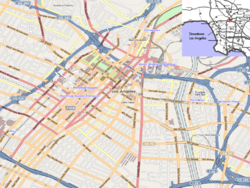Chinatown, Los Angeles
| Chinatown | |
|---|---|
| Neighborhood of Los Angeles | |

Entrance to Los Angeles' Chinatown
|
|
 Map of the Chinatown neighborhood of Los Angeles, as delineated by the Los Angeles Times |
|
| Location within Downtown Los Angeles | |
| Coordinates: 34°03′46″N 118°14′16″W / 34.062888°N 118.23789°W |
Chinatown is a neighborhood in Downtown Los Angeles, California that became a commercial center for Chinese and other Asian businesses in Central Los Angeles in 1938. The area includes restaurants, shops and art galleries but also has a residential neighborhood with a low-income, aging population of about 10,000 residents.
The original Chinatown developed in the late 19th century, but it was demolished to make room for Union Station, the city's major ground-transportation center. A separate commercial center, known as "New Chinatown," opened for business in 1938.
There are two schools and a branch library in Chinatown, as well as a city park, a state park and a medical center and hospital. Many motion pictures have been filmed in the area.
In the early 1860s, thousands of Chinese men, most of them originating from Guangdong province in southern China, were hired by Central Pacific Railroad Co. to work on the western portion of the first transcontinental railroad. Many of them settled in Los Angeles.
In 1871, nineteen Chinese men and boys were killed by a mob of about five hundred white men in one of the most serious incidents of racial violence that has ever occurred in America's West. This incident became known as "Massacre of 1871".
The first Chinatown, centered on Alameda and Macy Streets (now Cesar Chavez Avenue), was established in 1880. Reaching its heyday from 1890 to 1910, Chinatown grew to approximately fifteen streets and alleys containing some two hundred buildings. It boasted a Chinese Opera theater, three temples, a newspaper and a telephone exchange. But laws prohibiting most Chinese from citizenship and property ownership, as well as legislation curtailing immigration, inhibited future growth.
...
Wikipedia

